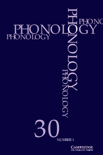
Phonology
Scope & Guideline
Elevating Phonological Studies to New Heights
Introduction
Aims and Scopes
- Theoretical Phonology:
Exploration of frameworks and models that explain phonological phenomena, including Optimality Theory, Harmonic Serialism, and various approaches to morphological tone. - Phonological Acquisition and Learning:
Research on how phonological systems are acquired, including studies on biases in learning and the role of implicit vs. explicit processes in understanding phonological concepts. - Tone and Stress Systems:
Investigation into the role of tone and stress in various languages, including grammatical tone, stress patterns, and their implications for phonological theory. - Phonetics-Phonology Interface:
Studies examining the interaction between phonetics and phonology, including acoustic properties and articulatory coordination. - Cross-Linguistic Studies:
Analysis of phonological phenomena across different languages, contributing to a broader understanding of universal phonological principles.
Trending and Emerging
- Emergent Phonology:
A focus on how phonological systems can emerge and develop, often through novel frameworks that challenge traditional views. This theme is increasingly relevant as researchers seek to understand phonological processes in real-time language use. - Learning and Cognition in Phonology:
Research on implicit and explicit learning processes in phonological concept acquisition is on the rise, emphasizing the cognitive aspects of phonology and how learners interact with phonological rules. - Integration of Phonology and Other Domains:
There is a noticeable trend towards examining the intersections of phonology with other linguistic domains, such as syntax and morphology, suggesting a more holistic approach to understanding language structure. - Experimental and Cross-Disciplinary Approaches:
An increase in studies employing experimental methods and cross-disciplinary perspectives, including phonetic analysis and computational modeling, indicates a shift towards more empirical research methodologies. - Focus on Tone Systems:
Research on grammatical tone and its implications for phonological theory has seen a marked increase, highlighting the significance of tone in understanding phonological structures across languages.
Declining or Waning
- Historical Phonology:
Research focusing on the diachronic aspects of phonology, such as sound change and historical linguistics, seems to be less prominent in recent issues, possibly as the field shifts towards more empirical and experimental approaches. - Phonological Theories with Limited Applicability:
Certain phonological theories that have not gained traction or have been deemed less applicable in current research contexts are appearing less frequently, indicating a shift towards more universally accepted frameworks. - Morphosyntactic Interfaces:
While still relevant, studies specifically examining the interfaces between phonology and morphosyntax seem to be declining in frequency, as more researchers gravitate towards direct phonological inquiries.
Similar Journals

Languages
Exploring the rich tapestry of language and its applications.Languages, published by MDPI, is a prestigious open-access journal dedicated to the field of Linguistics and Language studies. Since its inception in 2016, this journal has rapidly established itself as a leading platform for high-quality research, achieving an impressive Q1 ranking in 2023 and standing out in both the Arts and Humanities as well as the Social Sciences categories with significant percentile rankings (76th and 74th respectively). Based in Switzerland, Languages fosters an international community of scholars who are committed to exploring the multifaceted dimensions of language, from theoretical frameworks to practical applications. With a robust e-ISSN of 2226-471X, the journal prioritizes accessibility, allowing researchers, professionals, and students to freely engage with cutting-edge research and insights. By bridging the gap between theory and practice, Languages plays a crucial role in advancing our understanding of linguistic phenomena, making it an invaluable resource for anyone invested in the study of language.
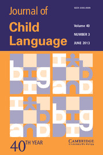
JOURNAL OF CHILD LANGUAGE
Advancing Insights into Child Language AcquisitionJOURNAL OF CHILD LANGUAGE, published by Cambridge University Press, is a premier scholarly journal dedicated to the exploration and examination of language development in children. Since its inception in 1974, the journal has become an authoritative source in the fields of Developmental and Educational Psychology, Experimental and Cognitive Psychology, and Linguistics, boasting significant impact as evidenced by its ranking in the top quartiles across these domains. With an impressive impact factor and a commitment to advancing research, the journal serves as a vital platform for researchers, educators, and practitioners interested in the intricacies of language acquisition and cognitive development in children. The 2023 Category Quartiles place it in Q1 for Linguistics and Language, further establishing its excellence. Fostering a rich intellectual community, the journal invites contributions that advance our understanding of child language, promising a broad readership in both the social sciences and humanities.

Language Dynamics and Change
Innovating Research on Language Variation and ChangeLanguage Dynamics and Change is a premier academic journal dedicated to exploring the evolution, variation, and transformation of languages over time. Published by BRILL, a reputable name in scholarly publishing, this journal aims to provide researchers, professionals, and students with a robust platform for disseminating cutting-edge findings in the field of linguistics. With an impressive Q1 quartile ranking in the Linguistics and Language category and a commendable ranking of #170 out of 1088 in the Arts and Humanities sector, it occupies a significant position in the academic landscape, showcasing innovative research that fosters a deeper understanding of language dynamics. Although it does not currently offer open access, the journal is committed to enhancing accessibility through various distribution channels. As we look ahead to its convergence period extending until 2024, Language Dynamics and Change continues to affirm its status as a vital resource for advancing the study of language evolution worldwide.

Language and Cognition
Exploring the Intersection of Language and MindLanguage and Cognition is a premier peer-reviewed journal published by Cambridge University Press, dedicated to advancing the fields of language, linguistics, and cognitive psychology. With an ISSN of 1866-9808 and E-ISSN of 1866-9859, it has rapidly established itself as a pivotal resource for researchers, educators, and practitioners alike. Recognized for its rigorous scholarship, the journal holds a Q1 ranking in Linguistics and Language and a Q2 ranking in Experimental and Cognitive Psychology for 2023, reflecting its esteemed positioning within the academic community. Since transitioning to open access in 2023, it has broadened its reach, making cutting-edge research accessible to a global audience. The journal's emphasis on interdisciplinary studies ensures a comprehensive exploration of the interactions between language and cognitive processes, fostering deeper insights and fostering collaboration across domains. Researchers and professionals looking to stay at the forefront of advancements in these vital areas will find Language and Cognition an invaluable platform for disseminating their findings and engaging with contemporary debates.
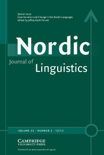
Nordic Journal of Linguistics
Connecting scholars through innovative linguistic studies.Nordic Journal of Linguistics, published by Cambridge University Press, serves as a prominent platform for the dissemination of cutting-edge research in the field of linguistics. Established in 1978 and spanning over four decades, the journal has curated a rich repository of scholarly work that reflects the dynamic and evolving nature of language studies. With an impressive Q2 ranking in both the Linguistics and Language category and a commendable performance in Scopus rankings, placing it at the 74th percentile among Arts and Humanities, the journal is recognized for its high academic standards and impact on contemporary linguistic research. Scholars and practitioners can access a variety of studies that delve into different languages, linguistic theories, and methodologies, fostering broader understanding and dialogue within the linguistic community. Although the journal does not currently offer open-access options, it remains an invaluable resource for researchers, professionals, and students keen on advancing their knowledge of language and linguistics.

Language and Linguistics
Fostering Interdisciplinary Approaches to LinguisticsLanguage and Linguistics is a leading academic journal published by ACAD SINICA, INST LINGUISTICS, based in Taiwan. Established in 2008, this journal has rapidly gained recognition within the field of linguistics, achieving a commendable ranking of Q2 in the 2023 category quartiles and holding positions in the top percentiles of Scopus rankings for both Arts and Humanities and Social Sciences. With an ISSN of 1606-822X and an E-ISSN of 2309-5067, the journal aims to foster the development of linguistics research by providing a platform for the dissemination of innovative and interdisciplinary studies. While it currently operates on a traditional subscription model, its significant contribution to the advancement of linguistic theory and its applications makes it an invaluable resource for researchers, professionals, and students alike. Spanning converged years from 2008 to 2024, Language and Linguistics continues to shape the dialogue in understanding language phenomena and encourages submissions that push the boundaries of current linguistic knowledge.
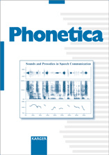
PHONETICA
Unveiling the Science of Sound in LanguagePHONETICA, published by De Gruyter Mouton, is a premier journal specializing in the interdisciplinary study of phonetics, phonology, and their applications in linguistics and acoustic sciences. With an impressive scope covering critical aspects of acoustics and language, PHONETICA has established itself as a leading platform for innovative research since its inception in 1957, continuing through to 2024. The journal boasts a significant impact, reflected in its esteemed Q1 ranking in both Acoustics and Ultrasonics and Linguistics and Language categories as of 2023, positioning it in the top quartile of scholarly journals in its field. PHONETICA's rigorous publication standards attract a diverse array of researchers and professionals, eager to disseminate their findings in an engaging and scholarly environment. Although not open access, the journal remains a vital resource for those seeking to deepen their understanding and contribute to the evolving dialogue in phonetic research.
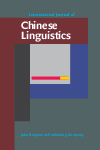
International Journal of Chinese Linguistics
Transforming Understanding of Chinese Linguistic DynamicsInternational Journal of Chinese Linguistics is a distinguished publication that delves into various aspects of linguistic studies pertaining to the Chinese language. Published by John Benjamins Publishing Co, this journal stands out for its commitment to advancing the knowledge and understanding of Chinese linguistics within the global academic community. With an impact factor that places it in the Q2 quartile of linguistics and language, the journal is indexed in prominent databases, achieving ranks of #501 in Arts and Humanities and #580 in Social Sciences. These rankings reflect the journal's dedication to maintaining high scholarly standards and its relevance in both linguistic research and practical applications. While not categorized as Open Access, the journal provides necessary access through institutional subscriptions, thereby ensuring that valuable research reaches a broad audience. Covering a wide range of topics from syntax and phonetics to sociolinguistics and applied linguistics, the International Journal of Chinese Linguistics serves as an essential resource for researchers, professionals, and students seeking to deepen their understanding of the intricate relationship between language and culture in the Chinese context. With converging years from 2019 to 2024, it continues to evolve, reflecting ongoing developments in the field.
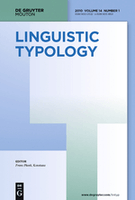
Linguistic Typology
Unveiling the Rich Tapestry of Language ClassificationLinguistic Typology is a premier journal focused on the comparative study of language structures and the classification of languages, published by Walter de Gruyter GmbH in Germany. Since its inception in 1997, the journal has established itself as a leading platform in the field of linguistics, achieving a remarkable Q1 category ranking in both Linguistics and Language for 2023, reflecting its impact and relevance among scholars. With a notable position in the academic community, evidenced by its 91st percentile rank in Arts and Humanities and 90th percentile in Social Sciences according to Scopus, Linguistic Typology invites contributions that explore the rich diversity of language structures, promoting a deeper understanding of linguistic phenomena across various cultures. While currently not offering open access, the journal remains a pivotal resource for researchers, professionals, and students aiming to advance their knowledge in the dynamic field of linguistics. For more information, deliverables, and submission guidelines, please visit the journal's official page.

NATURAL LANGUAGE & LINGUISTIC THEORY
Unraveling the Complexities of Natural LanguageNATURAL LANGUAGE & LINGUISTIC THEORY, published by Springer, stands as a premier journal in the field of linguistics, characterized by its rigorous examination of theoretical frameworks and current research trends within natural language. With the ISSN 0167-806X and E-ISSN 1573-0859, this journal has maintained a stellar reputation since its inception in 1983, consistently ranked in the Q1 category for Linguistics and Language as of 2023. Its impressive standing in Scopus ranks (#127 in Arts and Humanities and #143 in Social Sciences) further underscores its influence, occupying the 88th and 87th percentiles respectively. Although the journal does not provide Open Access options, it remains a vital resource for scholars and practitioners seeking to deepen their understanding of the nuances of linguistic theory. The journal's scope encompasses a wide array of topics relevant to both theoretical analysis and practical applications in linguistics, making it essential reading for anyone engaged in the study of language sciences.